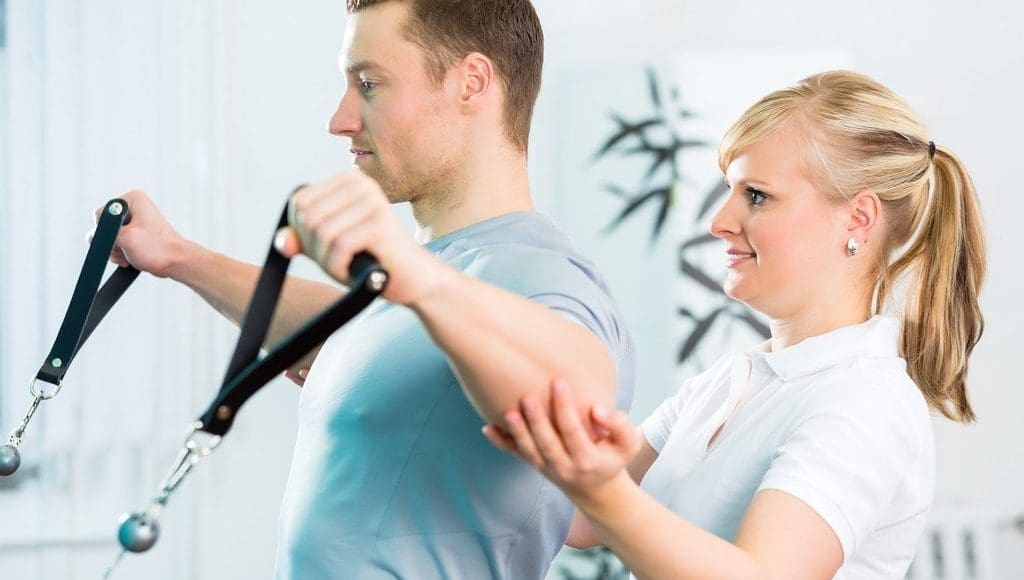Once you’ve developed symptoms of back pain, you may need to visit a physical therapist. A physical therapist will then work together with the patient to help restore their original mobility and help heal their body as a whole. Moreover, the therapist can also recommend a series of methods and techniques to help the individual minimize their pain and symptoms in the future.
Physical therapy includes both passive and active treatment options. Passive treatments are helpful for helping people relax while also helping the body heal. These are referred to as passive treatments because the patient does not need to actively participate in them to experience the benefits. Most physical therapy treatment plans may begin with passive treatment while the body begins to heal, however, the goal is to ultimately get the patient to participate in active treatments. Therapeutic exercises can help strengthen the body in order to help prevent future episodes of back pain.
Table of Contents
Passive Treatments
A physical therapist may offer the following passive treatments including:
Deep Tissue Massage: This treatment method targets chronic muscle tension and/or spasms that build up as a result of daily life stress. Muscle tension or spasms can also be caused due to strains or sprains from sports injuries or trauma from an accident. A physical therapist can apply direct pressure and friction to the affected region in order to release the tension in the soft tissues, such as ligaments, tendons and muscles.
Hot and Cold Therapies: A physical therapist can alternate between using hot and cold treatment methods for a variety of symptoms. Through the use of heat therapy, for instance, the therapist can achieve an increased blood flow, bringing more oxygen and nutrients to the affected regions of the body. Good blood circulation is essential to remove waste products which may have manifested due to muscle spasms in addition to helping the patient heal. Through the use of cold therapy, for example, also referred to as cryotherapy, blood flow is decreased or slowed down to help reduce pain and inflammation from muscle spasms. Applying a cold pack to the affected region or an ice massage are common ways of applying cold therapy. Another option to cryotherapy is a spray called fluoromethane, which functions by cooling the tissues. After the application of ice to the affected area of the body, a physical therapist may help stretch the affected muscles to improve healing.
Transcutaneous nerve stimulation or TENS: A TENS machine helps stimulate the muscles through the use of electrical currents which help reduce muscle spasms by boosting the body’s production of endorphins, or the body’s natural pain killers. The TENS equipment a physical therapist utilizes can be considerably large, but smaller TENS units are available for use at home. Utilizing transcutaneous nerve stimulation can be beneficial.
Ultrasound: This form of treatment helps reduce muscle spasms, cramping, swelling, stiffness and pain by also increasing blood circulation. This is achieved by sending sound waves deep into the muscles and other tissues of the body, creating mild heat which functions to enhance blood flow.
Active Treatments
Active physical therapy treatments a therapist can perform includes guiding the patient through a series of stretches and exercises which can help improve the body’s overall strength, mobility, flexibility and stability. Each person’s physical therapy program should be specialized according to their specific needs and their type of injury or condition. Taking into consideration the individual’s specific quality of life, health and well-being, particularly for someone who has back pain symptoms, the physical therapist should develop a physical activity program which will best benefit the patient.
If needed, you may additionally need to learn how to correct your posture and incorporate ergonomic principles into your daily activities. This is all part of the “self-care” or “self-treatment” aspect of physical therapy: through physical therapy, you learn good habits and principles that enable you to take better care of your body. Your physical therapist may also suggest a personalized exercise program for you. This can help reduce the likelihood of your back pain recurring and can also improve your overall health and wellness.
The scope of our information is limited to chiropractic and spinal injuries and conditions. To discuss options on the subject matter, please feel free to ask Dr. Jimenez or contact us at 915-850-0900 . 
By Dr. Alex Jimenez
Additional Topics: What is Chiropractic?
Chiropractic care is an well-known, alternative treatment option utilized to prevent, diagnose and treat a variety of injuries and conditions associated with the spine, primarily subluxations or spinal misalignments. Chiropractic focuses on restoring and maintaining the overall health and wellness of the musculoskeletal and nervous systems. Through the use of spinal adjustments and manual manipulations, a chiropractor, or doctor of chiropractic, can carefully re-align the spine, improving a patient’s strength, mobility and flexibility.
.video-containerposition: relative; padding-bottom: 63%; padding-top: 35px; height: 0; overflow: hidden;.video-container iframeposition: absolute; top:0; left: 0; width: 100%; height: 100%; border: none; max-width:100%!important;
TRENDING TOPIC: EXTRA EXTRA: New PUSH 24/7®? Fitness Center
Post Disclaimer
Professional Scope of Practice *
The information on this blog site is not intended to replace a one-on-one relationship with a qualified healthcare professional or licensed physician and is not medical advice. We encourage you to make healthcare decisions based on your research and partnership with a qualified healthcare professional.
Blog Information & Scope Discussions
Welcome to El Paso's Premier Wellness and Injury Care Clinic & Wellness Blog, where Dr. Alex Jimenez, DC, FNP-C, a board-certified Family Practice Nurse Practitioner (FNP-BC) and Chiropractor (DC), presents insights on how our team is dedicated to holistic healing and personalized care. Our practice aligns with evidence-based treatment protocols inspired by integrative medicine principles, similar to those found on this site and our family practice-based chiromed.com site, focusing on restoring health naturally for patients of all ages.
Our areas of chiropractic practice include Wellness & Nutrition, Chronic Pain, Personal Injury, Auto Accident Care, Work Injuries, Back Injury, Low Back Pain, Neck Pain, Migraine Headaches, Sports Injuries, Severe Sciatica, Scoliosis, Complex Herniated Discs, Fibromyalgia, Chronic Pain, Complex Injuries, Stress Management, Functional Medicine Treatments, and in-scope care protocols.
Our information scope is limited to chiropractic, musculoskeletal, physical medicine, wellness, contributing etiological viscerosomatic disturbances within clinical presentations, associated somato-visceral reflex clinical dynamics, subluxation complexes, sensitive health issues, and functional medicine articles, topics, and discussions.
We provide and present clinical collaboration with specialists from various disciplines. Each specialist is governed by their professional scope of practice and their jurisdiction of licensure. We use functional health & wellness protocols to treat and support care for the injuries or disorders of the musculoskeletal system.
Our videos, posts, topics, subjects, and insights cover clinical matters and issues that relate to and directly or indirectly support our clinical scope of practice.*
Our office has made a reasonable effort to provide supportive citations and has identified relevant research studies that support our posts. We provide copies of supporting research studies available to regulatory boards and the public upon request.
We understand that we cover matters that require an additional explanation of how they may assist in a particular care plan or treatment protocol; therefore, to discuss the subject matter above further, please feel free to ask Dr. Alex Jimenez, DC, APRN, FNP-BC, or contact us at 915-850-0900.
We are here to help you and your family.
Blessings
Dr. Alex Jimenez DC, MSACP, APRN, FNP-BC*, CCST, IFMCP, CFMP, ATN
email: coach@elpasofunctionalmedicine.com
Licensed as a Doctor of Chiropractic (DC) in Texas & New Mexico*
Texas DC License # TX5807
New Mexico DC License # NM-DC2182
Licensed as a Registered Nurse (RN*) in Texas & Multistate
Texas RN License # 1191402
ANCC FNP-BC: Board Certified Nurse Practitioner*
Compact Status: Multi-State License: Authorized to Practice in 40 States*
Graduate with Honors: ICHS: MSN-FNP (Family Nurse Practitioner Program)
Degree Granted. Master's in Family Practice MSN Diploma (Cum Laude)
Dr. Alex Jimenez, DC, APRN, FNP-BC*, CFMP, IFMCP, ATN, CCST
My Digital Business Card



